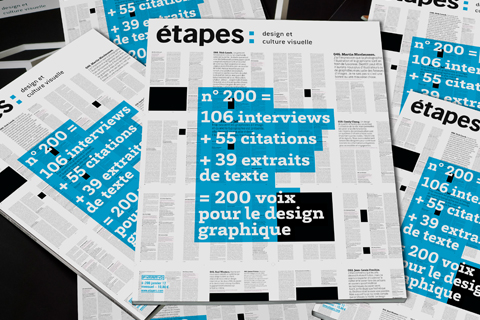My latest article, “Yourselves: Declaring Ourselves,” is posted on the Design Observer blog in the “Observatory” section. The piece looks at the history and mission of the AIGA Design Educators Community—I serve on the organization’s steering committee. Particular focus in the article is given to the DEC’s current initiatives.
Tag: design education
AIGA Design Educators Community
I’m proud to have been named to the AIGA Design Educators Community Steering Committee for a three-year term. The DEC’s mission is to enhance the abilities of design educators and educational institutions to prepare future designers for excellence in design practice, design theory and design writing at the undergraduate and graduate levels, while supporting the fundamental mission of AIGA. A major initiative of the DEC is sponsorship of annual design education conferences such as Blunt.
Étapes numéro deux cent

I am one of the 200 “voix pour le design graphique” included in the 200th issue of the French design magazine étapes. The special issue presents the comments of designers, collectors, curators, festival organizers, teachers, and critics on aspects of the state of contemporary graphic design. I was asked to respond to a brief questionnaire on critical writing. If, like me, you’ve forgotten most of your high school French, here’s the text in English:
Q. Is there a renewal of interest in graphic art criticism? In your country or worldwide speaking?
A. Discussion of graphic design criticism has arguably increased but I can’t discern an increased interest for an actual criticism. There has been a spike in calls for additional celebratory journalism from the profession that is termed (but isn’t) “graphic design criticism.”
Q. How has this developed?
A. The graphic design field has little institutional memory since reading of criticism or graphic design history that’s not an examination of storied practitioners isn’t encouraged academically or professionally.
Q. How can stepping back and taking stock of graphic design help its practice evolve? Does it bring about a creative revival?
A. I don’t see practical evolution as the purpose of graphic design criticism. If engaged, criticism might bring about a deeper cultural and social awareness amongst practitioners by expanding graphic design beyond a “profession” and into a “discipline.”
Q. Are there opponents or obstacles to the existence of critical thinking?
A. The graphic design profession. Professions do not value or support critical literature, disciplines do.
Q. Should criticism be part of a graphic designer’s training?
A. For vocational training in graphic design, probably not. If meant as a component of an art and/or liberal arts education, yes.
Adventures Close to Home

I recently attended the AIGA design education conference New Contexts/New Meanings at North Carolina State University and participated in the “Social Economies: Enterprise and a New Cultural Geography” topic group as a co-author. While I enjoyed the discussion, I’m uncertain if I ever truly understood the premise of the debate—or contributed anything of value. However, concerns were raised that are of constant interest to me: community and engagement. Toward the end of the session, I had some thoughts that seemed applicable to the course the conversation took. Since time constraints didn’t allow me to test their relevance with the group, I offer them here.
Collaboration, community, and the necessity to “sensitize students to other cultures and socio-economic realities” were focal points of the serpentine discussion. The first two concerns have status as cultural buzzwords. Yet, they are real issues. Encouraging students to believe they are part of something larger than themselves and to work with a disparate group of people toward mutually beneficial ends is meaningful on immediate and abstract levels. The most immediate is that students must actively participate to enjoy a functioning and rewarding class. After that is the practical necessity to work on class projects as a group if so assigned. Abstractly, the class becomes a representation of society overall, and a place to model behavior in the various established and ad hoc communities that life presents.
In the conference session, different strategies were put forth to foster collaboration and cultural sensitivity in classes. One co-author described an ideal and envious team-taught course he’d been able to create at his institution (somewhat on the down low) that brought design students together with those from other disciplines to work on projects. Another proposed immersing students in other cultures directly: through field trips as far abroad as possible (going to China would be great but, failing that—Chinatown). Fostering sensitivity also extended to actions to generate awareness of the implications of design artifacts. Students should be informed in depth on the manufacturing and distribution processes of said artifacts.
These directions have obvious practical problems—obvious if you’re in academia, even if not. For instance, my attempt to fashion a course with a professor in Marketing years ago couldn’t get beyond the speculation stage due to that department’s work load/contact hour requirements. Those rules ensure professors are actively engaging students (well, that we’re put in contact with students, anyway) but squelch collaboration across disciplines. Some institutions are confronting these bureaucratic problems but academia isn’t known for a sprightly adaptation of the new. Field tripping is an institutionalized academic activity but comes with economic limitations for students and school.
It may be no great insight that as the group negotiated how to foster collaboration and community—and the novel structure of the conference itself, I increasingly saw our immediate activity as model and metaphor. The entirety of the ongoing effort to establish a design educator’s community is an enterprise of “new cultural geography.” The membership of just this one conference topic was multiracial, multiethnic, and multinational. The institutions we represented were similarly diverse in location, size, constitution, and resources. We possessed a diversity of opinions on various aspects of the specific topic and the many facets of design and teaching overall. Our conferences are our collaborations toward an intangible “product”—substantive teaching.
How this realization translates into lessons for the student is through transparency and sharing. For most students, education is a “black box”—its inner workings a mystery. I’ve always dished to my students about the behind-the-scenes activities and concerns that inform education—such as explaining the hiring, evaluation, and tenure processes. These are often my most popular lectures. Like it or not, students learn about the personal, professional, economic, and institutional pressures that shape what happens in the classroom. I agree that it’s advantageous to alert students to how things are made to the end of having more thoughtful and socially engaged practitioners. And along with paying a visit to the offset printing plant, I try to pull aside the classroom curtain and demonstrate how we work the levers of teaching.
I’ve also made it a point to inform my students about my conference experiences, just as I encourage them to share their working methods and inspirations. It surprises a significant number of students that their professors are studying and debating methods of teaching. Many might think we just show up and start talking (something I will do on many occasions but is another story). I hope my conference reports provide a direct proof that a broader and deeper discussion about design—deeper than its commercial application—is possible and burgeoning. And that education is a dynamic process that isn’t performed upon them—they must participate.
This transparency and sharing won’t magically create the desired community and awareness. But in our urging of students to engage in life-long learning, it shows we’re practicing what we preach. And that before we go looking far and wide for exotic cultures to immerse students in, we look right in front of us, and describe the cultural geography of where we stand.
